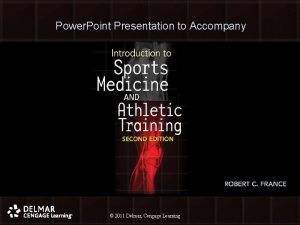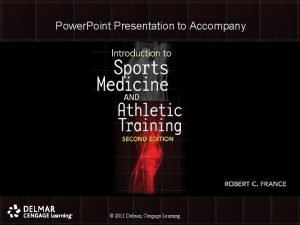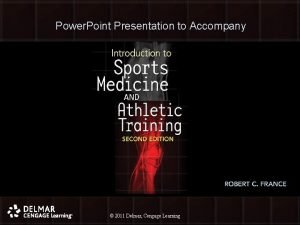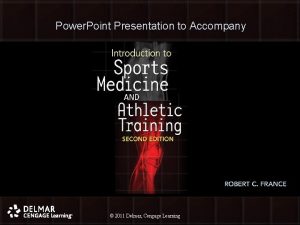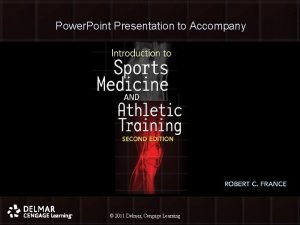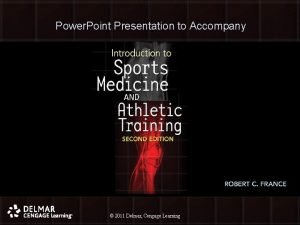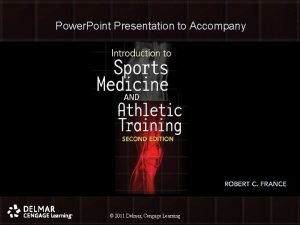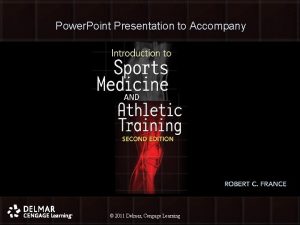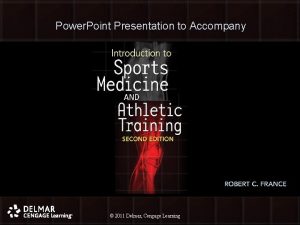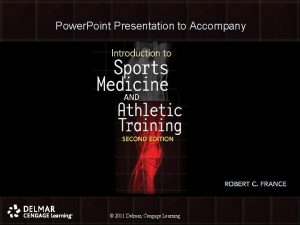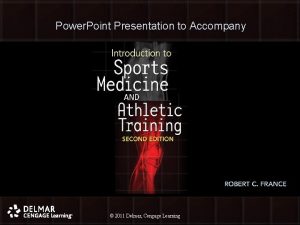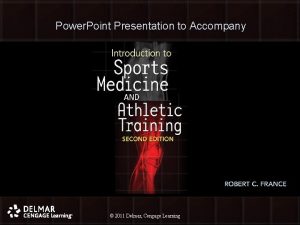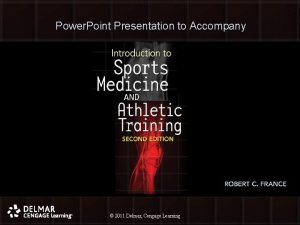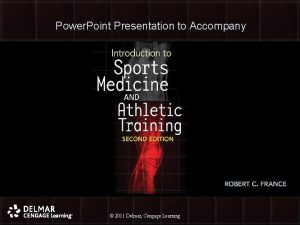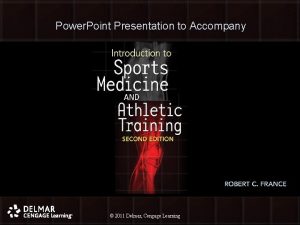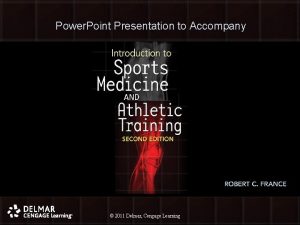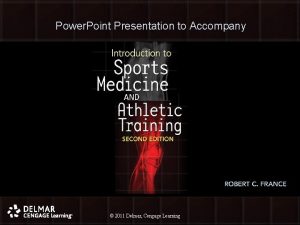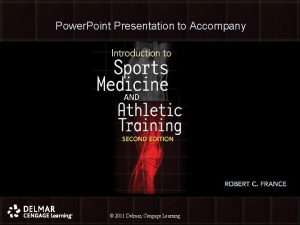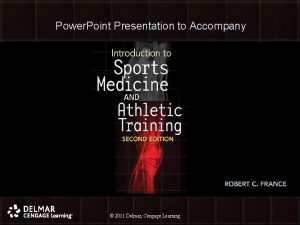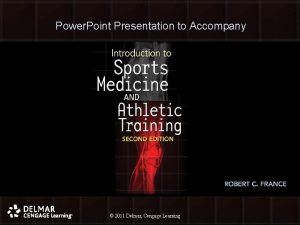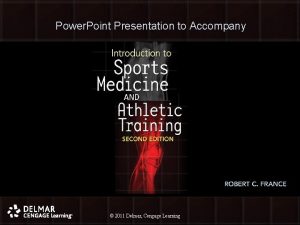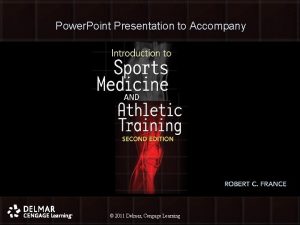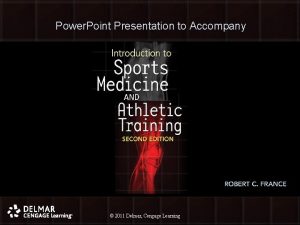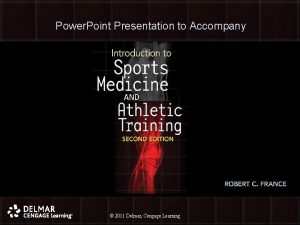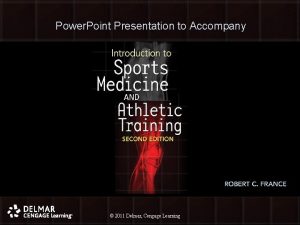Power Point Presentation to Accompany 2011 Delmar Cengage


































- Slides: 34

Power. Point Presentation to Accompany © 2011 Delmar, Cengage Learning © 2010 Delmar, Cengage Learning

Chapter 7 Prehabilitation and Preseason Conditioning © 2011 Delmar, Cengage Learning © 2010 Delmar, Cengage Learning 2

Objectives • Upon completion of this chapter, you should be able to: – Discuss how prehabilitation can decrease the chance of injury – Explain how preseason conditioning helps the body adapt to the demands placed upon it – Describe isometric, dynamic, and isokinetic exercise and how they are used in a conditioning program © 2011 Delmar, Cengage Learning © 2010 Delmar, Cengage Learning 33

Objectives (cont’d. ) • Upon completion of this chapter, you should be able to (cont’d. ): – Compare and contrast manual resistance training, circuit training, and special individualized programs – Describe the science behind progressive resistance exercise © 2011 Delmar, Cengage Learning © 2010 Delmar, Cengage Learning 44

Objectives (cont’d. ) • Upon completion of this chapter, you should be able to (cont’d. ): – Explain how stretching and flexibility are important components of an overall fitness program – Explain the benefits of cardiorespiratory training © 2011 Delmar, Cengage Learning © 2010 Delmar, Cengage Learning 55

Prehabilitation • Rehabilitation: – Programmed exercise program designed to return an athlete to fitness and competition • Prehabilitation: – Trying to prevent injuries before they occur, through a preventative management program – CDC reports that ½ child sports injuries are preventable with proper education & protective equipment © 2011 Delmar, Cengage Learning © 2010 Delmar, Cengage Learning 66

Prehabilitation • Prehab decreases chance of injury by addressing areas of concern or deficit identified BEFORE sports participation • Prehab program can be implemented to strengthen and develop these areas to reduce chance of injury during participation © 2011 Delmar, Cengage Learning © 2010 Delmar, Cengage Learning 77

Preseason Conditioning • Developing the athlete in the off-season • (similar to Prehab = general term for any time) – Athletes work on overall conditioning as well as concentrating on specific weaknesses • Preseason conditioning program – Begin six to eight weeks prior to sports participation • Allows body to gradually adapt to demands – Doing too much, too soon or too high an intensity may not adapt effectively injury risk © 2011 Delmar, Cengage Learning © 2010 Delmar, Cengage Learning 88

Preseason Conditioning (cont’d. ) • Sports medicine physicians, certified athletic trainers, and qualified youth coaches prescribe preseason conditioning programs – Provide athletes with information on the type, frequency, intensity, and duration of training – Coach Felix © 2011 Delmar, Cengage Learning © 2010 Delmar, Cengage Learning 99

Preseason conditioning, cont Summary: • Allows athletes to gradually build up to the level of activity that will be expected of them on the field/court. • By starting slowly, the body can adjust to new demands • Once the body has accommodated, the athletes can increase the intensity of conditioning • Thus, working incrementally to adjust the body, the athlete prepares for the demands of the season and reduces chance of injury © 2011 Delmar, Cengage Learning © 2010 Delmar, Cengage Learning 1010

Strength Training • Body changes in response to increased training load – Adaptation is the whole purpose of strength training – Requires a systematic application of exercise stress • Stress should be sufficient to stimulate muscle fatigue, but not so severe that breakdown and injury occur © 2011 Delmar, Cengage Learning © 2010 Delmar, Cengage Learning 1111

Strength Training (cont’d. ) • Hypertrophies – Muscle is worked beyond its normal limits, adapts and becomes larger – Proteins grow; not exactly sure how: combo of satellite cells (repair), immune system reactions and growth factor proteins • Atrophies – Muscle is worked less than normal and becomes smaller – Can’t do what it once did © 2011 Delmar, Cengage Learning © 2010 Delmar, Cengage Learning 1212

Strength Training (cont’d. ) • Progressive resistance exercise – Body adapts to increased demand by training – Work until muscle reaches capacity then add more © 2011 Delmar, Cengage Learning © 2010 Delmar, Cengage Learning 1313

Strength Training (cont’d. ) • Overload – Muscles must be overloaded to improve strength; push them! – ONLY do btwn 4 -8 reps; sets 3+ – The last rep should be difficult, but not impossible and you should be able to do it again, with good form. If your form slips, stop early or try a lighter weight – Rest (between sets as well as rest days) • Specificity- to focus on a specific area – Muscles adapt to nature of work performed, so… swimmers should train in the water – Still need to work ALL aspects of exercise to experience optimal performance • Ex: can’t JUST do sit-ups to get toned abs. . . • Reversibility – Muscles disuse leads to a decrease in strength and muscle mass 1414 © 2011 Delmar, Cengage Learning © 2010 Delmar, Cengage Learning

Slow vs fast-twitch Motor units- the nerves innervating the muscle • Slow-twitch: fatigue-resistant (distance runners); high reps, low intensity • Fast-twitch: contract more rapidly & forcefully, but fatigue rapidly (sprinters; strength athletes); low reps, high intensity -train for both and don’t leave one type out (do both endurance and bursts to train effectively) © 2011 Delmar, Cengage Learning © 2010 Delmar, Cengage Learning 1515

Strength Training (cont’d. ) • Reversibility – Muscles not used, immobilized or starved lead to a decrease in strength and muscle mass – After Injury: slow-twitch atrophy quicker • Again, rehab both types for effective recovery • Individual differences – Fast vs. slow twitch fibers – People vary in the rate at which they gain strength – Fibers are genetically determined but can still be gained with a good training program © 2011 Delmar, Cengage Learning © 2010 Delmar, Cengage Learning 1616

summary • Progressive resistance training allows the body to adapt to the demands placed on it through training. 4 factors determine rate and type of strength gain: • Overload- overwork of muscles at tensions close to their maximum • Specificity: targeting particular muscle group to improve & gain strength in that muscle group alone. • Reversibility: decrease in strength and mass with disuse • Individual differences: ability to strengthen certain muscles at a particular rate. Genetics have a strong influence on strength gain. © 2011 Delmar, Cengage Learning © 2010 Delmar, Cengage Learning 1717

Strength Training Exercises • Isometric exercise – Muscles contract, but there is no motion in the affected joints – Constant length through entire contraction – Usually performed against an immovable surface or object – Convenient method for overload & strength w/o equipment – Often used for rehabilitation • Exact area of muscle weakness can be isolated • Strengthening is administered at the proper joint angle • Avoid these for people with poor circulation, high blood pressure © 2011 Delmar, Cengage Learning © 2010 Delmar, Cengage Learning 1818

isometric © 2011 Delmar, Cengage Learning © 2010 Delmar, Cengage Learning 1919

Strength Training Exercises (cont’d. ) • Dynamic exercise (isotonic) – Movement of the joint during muscle contraction (e. g. , weight training with dumbbells and barbells) – Muscle shortens & lengthens – Dynamic stretching: • Allows body to warm up And stretch © 2011 Delmar, Cengage Learning © 2010 Delmar, Cengage Learning 2020

Strength Training Exercises (cont’d. ) • Manual resistance training -w/ partner, w/ spotter -help control technique -add resistance to fatigue then release to allow lift to be completed © 2011 Delmar, Cengage Learning © 2010 Delmar, Cengage Learning 2121

Strength Training Exercises (cont’d. ) • Isokinetic exercise – Machines control speed of contraction within range of motion • Combines isometrics and weight training – Muscular overload is constant, mobilizes force at full ROM • Stationary bike set at 90 rev/min – Generally not for individual use; more in PT settings; Cybex & Biodex © 2011 Delmar, Cengage Learning © 2010 Delmar, Cengage Learning 2222

Strength training- isokinetic © 2011 Delmar, Cengage Learning © 2010 Delmar, Cengage Learning 2323

Strength Training Exercises (cont’d. ) • Circuit training – Six to ten strength exercises completed as a circuit – Improves strength and stamina; targets different muscle groups – Minimum amount of rest © 2011 Delmar, Cengage Learning © 2010 Delmar, Cengage Learning 2424

HIIT vs. Circuit • Unlike circuit training, interval training has less to do with what you're doing and, instead, is mostly about the intensity of what you're doing. • For example, you could do interval training with one movement (like kettlebell swings), several movements (like burpees, squat jumps, and plyo lunges), or with a strictly cardio exercise (like running or rowing). All that matters is that you're working (hard!) for a certain period of time and resting for a certain period of time. © 2011 Delmar, Cengage Learning © 2010 Delmar, Cengage Learning 2525

summary • In isometric exercise, the muscles maintain a constant length throughout the contraction. This type of exercise targets an exact area of weakness due to an injury. In dynamic (or isotonic) exercise, there is movement of the joint during muscle contraction. This type of exercise helps improve blood circulation, strength, and endurance. Isokinetic exercises use machines to control the speed of the contraction within a range of motion. These exercises provide muscle overload at a constant, preset speed and full range of motion. © 2011 Delmar, Cengage Learning © 2010 Delmar, Cengage Learning 2626

Strength Training Exercises (cont’d. ) • Stretching – Moving joints beyond normal range of motion – Helps with prevention and treatment – muscle length = ROM • They can move further before suffering injury – MUST warm-up to help increase heart rate, blood pressure, respiratory rate to help with quicker delivery of oxygen & nutrients to muscles = optimal performance • Active ppl more flexible; females, young • Flexibility • As important as strength & endurance Ability of a joint to move – Order: freely through full range of • Dynamic warm up motion • Stretch https: //www. quora. com/Is • Train/acitivity the-female-body-moreflexible-than-the-male-body © 2011 Delmar, Cengage Learning © 2010 Delmar, Cengage Learning 2727

Strength Training Exercises (cont’d. ) • Static stretching – Gradual stretching of a muscle through the muscle’s entire range of motion – Hold for more than 30 seconds, THEN gradually push through as stretch reflex fades • Ballistic stretching – popular like 25 yrs ago – Rhythmical, bouncing action – injury due to activation of stretch reflex, results in tears – Don’t do it, but you probably don’t… © 2011 Delmar, Cengage Learning © 2010 Delmar, Cengage Learning 2828

• Proprioceptive neuromuscular facilitation – Combination of contraction and relaxation of muscles • Proprioceptive: stimuli in muscles, tendons, other internal tissues • Neuromuscular: muscles, nerves (motor unit) • Facilitation: enhancement of any natural process -Starts w/ initial isometric contraction (not moving) -hold for 6 -8 secs -relax -passive stretch (you relax while assistant stretches you) or you can use bands hamstrings PNF © 2011 Delmar, Cengage Learning © 2010 Delmar, Cengage Learning 2929

Cardiorespiratory Conditioning -Known as aerobic or endurance training that puts demands on the lungs & heart -Uses large muscles groups for jogging, swimming, cycling, etc -Soccer & water polo excellent for aerobic conditioning -Goal= train heart & skeletal muscles to use oxygen more efficiently so one can exercise for longer period of time • Muscular endurance – Ability of muscles to sustain high-intensity, aerobic exercise • Ex: weightlifter completing 20 bench presses at 150 lbs in 60 secs. • Cardiorespiratory endurance- whole body’s ability to sustain prolonged, rhythmical exercise ex: 5 - mile run © 2011 Delmar, Cengage Learning © 2010 Delmar, Cengage Learning 3030

Cardiorespiratory Conditioning (cont’d. ) • heart size = pumping volume – Resting heart rate (more rest) • amount of air exchanged more efficient oxygen transfer to blood © 2011 Delmar, Cengage Learning © 2010 Delmar, Cengage Learning 3131

Cardiorespiratory Conditioning (cont’d. ) • An aerobic conditioning program should take into account: – Beginning fitness level – Age – gender – Physical limitations © 2011 Delmar, Cengage Learning © 2010 Delmar, Cengage Learning 3232

Special Individualized Programs • Cost depends on program type and amount of time devoted to personalized instruction • Personal trainers should be certified – The National Federation of Professional Trainers – The International Sport Sciences Association – The American College of Sports Medicine • Athletes should “comparison shop” to find a personal trainer to fit their needs © 2011 Delmar, Cengage Learning © 2010 Delmar, Cengage Learning 3333

Conclusion • Trying to prevent injuries before they occur is known as prehabilitation • Personalized programs are an integral component of the total athletic fitness program • There are many different ways to achieve fitness • Stretching and flexibility are important components of fitness • A well-thought-out stretching and flexibility program helps with injury prevention and treatment © 2011 Delmar, Cengage Learning © 2010 Delmar, Cengage Learning 3434
 2009 delmar cengage learning
2009 delmar cengage learning 2009 delmar cengage learning
2009 delmar cengage learning Introduction to medical terminology chapter 1 answer key
Introduction to medical terminology chapter 1 answer key Graphing tpr
Graphing tpr 2009 delmar cengage learning
2009 delmar cengage learning Chapter 13 medical math
Chapter 13 medical math 2009 delmar cengage learning
2009 delmar cengage learning Delmar cengage learning instructor resources
Delmar cengage learning instructor resources Hebrews 6:9-12 sermon
Hebrews 6:9-12 sermon Accompany chapter 1
Accompany chapter 1 Dorsal venous network
Dorsal venous network Accompany
Accompany Presentation in hindi topic
Presentation in hindi topic Power point presentation design west vancouver
Power point presentation design west vancouver Delmar isotonic
Delmar isotonic Delmar tsi
Delmar tsi Delmar custom broker
Delmar custom broker Thomson delmar learning
Thomson delmar learning Borgify
Borgify Power trianlge
Power trianlge Powerbi in powerpoint
Powerbi in powerpoint Point point power
Point point power Chapter 7:10 respiratory system
Chapter 7:10 respiratory system Cengage differential equations
Cengage differential equations Bank reconciliation cengage
Bank reconciliation cengage Cengage differential equations
Cengage differential equations Cengage chapter 7
Cengage chapter 7 Chapter 5 the cardiovascular system labeling exercises
Chapter 5 the cardiovascular system labeling exercises Cengage learning heart diagram
Cengage learning heart diagram Cengage
Cengage Cengage
Cengage Cengage
Cengage South-western cengage learning
South-western cengage learning Cengage
Cengage Cengage
Cengage














